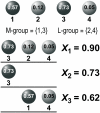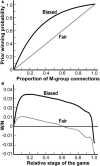Losing the battle but winning the war: game theoretic analysis of the competition between motoneurons innervating a skeletal muscle
- PMID: 22479244
- PMCID: PMC3315845
- DOI: 10.3389/fncom.2012.00016
Losing the battle but winning the war: game theoretic analysis of the competition between motoneurons innervating a skeletal muscle
Abstract
The fibers in a skeletal muscle are divided into groups called "muscle units" whereby each muscle unit is innervated by a single neuron. It was found that neurons with low activation thresholds have smaller muscle units than neurons with higher activation thresholds. This results in a fixed recruitment order of muscle units, from smallest to largest, called the "size principle." It is thought that the size principle results from a competitive process-taking place after birth-between the neurons innervating the muscle. The underlying mechanism of the competition was not understood. Moreover, the results in the majority of experiments that manipulated the activity during the competition period seemed to contradict the size principle. Experiments at the isolated muscle fibers showed that the competition is governed by a Hebbian-like rule, whereby neurons with low activation thresholds have a competitive advantage at any single muscle fiber. Thus neurons with low activation thresholds are expected to have larger muscle units in contradiction to what is seen empirically. This state of affairs was termed "paradoxical." In the present study we developed a new game theoretic framework to analyze such competitive biological processes. In this game, neurons are the players competing to innervate a maximal number of muscle fibers. We showed that in order to innervate more muscle fibers, it is advantageous to win (as the neurons with higher activation thresholds do) later competitions. This both explains the size principle and resolves the seemingly paradoxical experimental data. Our model establishes that the competition at each muscle fiber may indeed be Hebbian and that the size principle still emerges from these competitions as an overall property of the system. Thus, the less active neurons "lose the battle but win the war." Our model provides experimentally testable predictions. The new game-theoretic approach may be applied to competitions in other biological systems.
Keywords: Hebbian rule; game theory; neuromuscular junction; size principle; synapse elimination.
Figures




Similar articles
-
Synapse elimination, the size principle, and Hebbian synapses.J Neurobiol. 1995 Feb;26(2):273-82. doi: 10.1002/neu.480260211. J Neurobiol. 1995. PMID: 7707047
-
Competition favouring inactive over active motor neurons during synapse elimination.Nature. 1987 Jul 30-Aug 5;328(6129):422-6. doi: 10.1038/328422a0. Nature. 1987. PMID: 3614345
-
The resilience of the size principle in the organization of motor unit properties in normal and reinnervated adult skeletal muscles.Can J Physiol Pharmacol. 2004 Aug-Sep;82(8-9):645-61. doi: 10.1139/y04-081. Can J Physiol Pharmacol. 2004. PMID: 15523522 Review.
-
Activity-driven synapse elimination leads paradoxically to domination by inactive neurons.J Neurosci. 1999 Nov 15;19(22):9975-85. doi: 10.1523/JNEUROSCI.19-22-09975.1999. J Neurosci. 1999. PMID: 10559405 Free PMC article.
-
The perinatal reorganization of the innervation of skeletal muscle in mammals.Prog Neurobiol. 1990;34(1):39-90. doi: 10.1016/0301-0082(90)90025-c. Prog Neurobiol. 1990. PMID: 2406795 Review.
Cited by
-
Potassium currents dynamically set the recruitment and firing properties of F-type motoneurons in neonatal mice.J Neurophysiol. 2015 Sep;114(3):1963-73. doi: 10.1152/jn.00193.2015. Epub 2015 Aug 12. J Neurophysiol. 2015. PMID: 26269551 Free PMC article.
-
A neural algorithm for computing bipartite matchings.Proc Natl Acad Sci U S A. 2024 Sep 10;121(37):e2321032121. doi: 10.1073/pnas.2321032121. Epub 2024 Sep 3. Proc Natl Acad Sci U S A. 2024. PMID: 39226341 Free PMC article.
References
LinkOut - more resources
Full Text Sources
Miscellaneous

